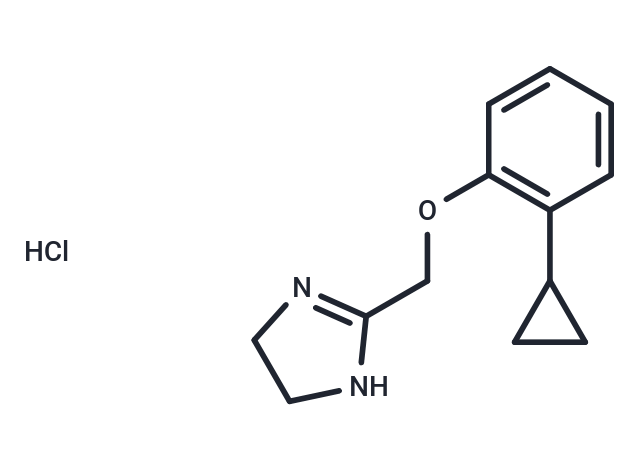Shopping Cart
Remove All Your shopping cart is currently empty
Your shopping cart is currently empty
Cirazoline hydrochloride is a synthetic compound that acts as a competitive full agonist of the α1A-adrenergic receptor (α1A-AR) with a binding affinity of Ki = 120 nM, and Cirazoline hydrochloride also functions as a partial agonist at α1B-AR (Ki = 960 nM) and α1D-AR (Ki = 660 nM), thereby serving as a versatile adrenergic receptor probe with relevance for studying vascular tone regulation, adrenergic pharmacology, and potential therapeutic cardiovascular applications.

| Pack Size | Price | USA Warehouse | Global Warehouse | Quantity |
|---|---|---|---|---|
| 1 mg | $58 | - | In Stock | |
| 5 mg | $139 | - | In Stock | |
| 10 mg | $213 | - | In Stock | |
| 25 mg | $359 | - | In Stock | |
| 50 mg | $533 | - | In Stock | |
| 100 mg | $759 | - | In Stock | |
| 200 mg | $987 | - | In Stock |
| Description | Cirazoline hydrochloride is a synthetic compound that acts as a competitive full agonist of the α1A-adrenergic receptor (α1A-AR) with a binding affinity of Ki = 120 nM, and Cirazoline hydrochloride also functions as a partial agonist at α1B-AR (Ki = 960 nM) and α1D-AR (Ki = 660 nM), thereby serving as a versatile adrenergic receptor probe with relevance for studying vascular tone regulation, adrenergic pharmacology, and potential therapeutic cardiovascular applications. |
| Targets&IC50 | AR-α1B:960 nM (Ki), AR-α1D:660 nM (Ki), AR-α1A:120 nM (Ki) |
| In vitro | Methods: Glioblastoma-initiating cells were treated with cirazoline hydrochloride (5-10 μM, 24 hours), and cell viability was measured using the WST-1 reduction assay. Results: Cirazoline hydrochloride did not alter the viability of GICs and only slightly antagonized prazosin-induced GIC death. [2] |
| In vivo | Methods: B6/CBA mice were treated with Cirazoline hydrochloride (drinking water, 40 μM, for 9 months) to investigate the influence of α1A-AR signaling in antidepressant effects. Results: Wild-type mice with long-term intake of Cirazoline hydrochloride showed a significant reduction in immobility time during the TST (tail suspension test). [1]. |
| Synonyms | LD3098 hydrochloride |
| Molecular Weight | 252.74 |
| Formula | C13H17ClN2O |
| Cas No. | 40600-13-3 |
| Smiles | Cl.N1=C(NCC1)COC=2C=CC=CC2C3CC3 |
| Relative Density. | 1.25g/cm3 |
| Color | White |
| Appearance | Solid |
| Storage | store at low temperature | Powder: -20°C for 3 years | In solvent: -80°C for 1 year | Shipping with blue ice/Shipping at ambient temperature. | ||||||||||||||||||||||||||||||
| Solubility Information | H2O: 24 mg/mL (94.96 mM), Sonication is recommended. | ||||||||||||||||||||||||||||||
Solution Preparation Table | |||||||||||||||||||||||||||||||
H2O
| |||||||||||||||||||||||||||||||
| Size | Quantity | Unit Price | Amount | Operation |
|---|

Copyright © 2015-2025 TargetMol Chemicals Inc. All Rights Reserved.